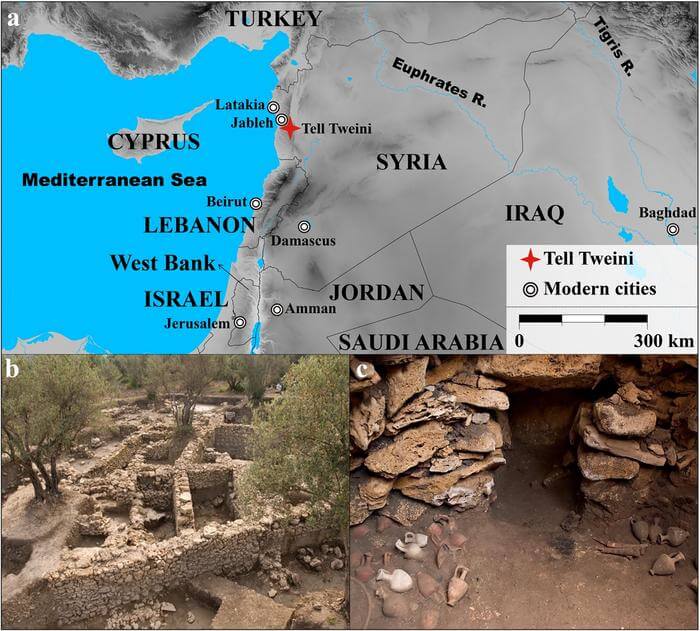
(Credit: Antonina Vlasova/Shutterstock)
LEUVEN, Belgium — Ancient humans: they're just like us! New research is shedding light on the agricultural practices and human diet during the Bronze and Iron Ages at the ancient harbor town of Tell Tweini in modern-day Syria. By analyzing plant, animal, and human remains spanning over 2,000 years, scientists have pieced together a surprisingly detailed and nuanced picture of life in this important Eastern Mediterranean settlement.
One of the most intriguing findings in the PLoS ONE study was that the inhabitants of Tell Tweini enjoyed a diet remarkably similar to the healthy “Mediterranean diet” of today. This diet emphasized wheat, olives, grapes, and pulses like bitter vetch, supplemented by small amounts of meat and dairy. The research team discovered that even during periods of major climate shifts and societal upheaval in the wider region, the people of Tell Tweini were able to maintain a robust and resilient agricultural system thanks to their proximity to wetlands and coastal areas.
The scientists also found evidence that the Bronze and Iron Age inhabitants used advanced farming techniques like crop rotation, fertilization with animal manure, and possibly even irrigation to ensure stable harvests of important crops like emmer wheat, barley, and grapes. Olive oil production, in particular, seems to have been a major economic activity at Tell Tweini, with the town potentially rivaling the major olive oil centers of the region.

Paper Summary
Methodology: Secrets in the Bones and Seeds
To uncover these ancient secrets, the researchers used a technique called stable isotope analysis. This process measures the ratios of different forms of elements like carbon and nitrogen that get incorporated into plant and animal tissues from the environment. By comparing these isotopic “fingerprints” in archaeological plant, animal, and human remains, scientists can reconstruct details about past climates, agricultural practices, animal diets, and human food consumption.
The team analyzed an impressive number of samples - 410 plant seeds, 210 animal bones, and 16 human bones - from four main periods of occupation at Tell Tweini, spanning from 2600 BC to 333 BC. Most of the human bones came from a fascinating discovery - a Middle Bronze Age mass grave under a house floor dated to around 1700 BC based on the large quantities of Cypriot pottery found with the skeletons.
Results: Bringing the Past to Life
The isotopic data allowed the researchers to paint a dynamic picture of Tell Tweini's agropastoral system over time. The d13C values in wheat, barley, and olive pits indicated that these crops were generally well-watered, suggesting the strategic use of wetlands, coastal areas, and possibly irrigation to buffer against the effects of regional drought.
Elevated d15N values in the wheat also pointed to the regular use of animal manure as fertilizer, a more intensive farming practice that seems to have increased over time. The d13C and d15N values in animal bones told a story of sheep, goats, and cattle grazing together in similar environments, with some individuals also consuming wild C4 plants from wetlands and disturbed areas.
When the scientists analyzed the human bones from the Middle Bronze Age mass grave, they found a surprising pattern. The individuals had relatively low d15N values, lower even than those of the dogs from the same period. This suggests that despite being buried with the trappings of wealth like imported pottery, these people ate a diet relatively low in animal protein and high in plant-based foods like wheat, bitter vetch, and olives.
Takeaways: Putting the Pieces Together
While opening an unprecedented window into the daily lives of Eastern Mediterranean people over 4,000 years ago, the study also had some limitations. Many animal and human bone samples failed to yield enough preserved collagen for analysis, likely due to the hot and arid climate. The researchers also had to use very broad date ranges for their samples due to the lack of precision dating for some periods.
Nevertheless, the research showcases the power of novel scientific techniques like stable isotope analysis to help fill in the gaps in the archaeological record. By integrating multiple lines of evidence from plant, animal, and human remains, the scientists were able to reconstruct the complex interplay of climate, environment, and human choices that shaped Tell Tweini's remarkable resilience over two millennia.
The study's findings demonstrate that the people of this ancient settlement were able to maintain a productive and sustainable agropastoral system through major climate shifts and societal disruptions by strategically exploiting diverse microenvironments and using innovative agricultural techniques. The research also highlights the deep roots of the healthy “Mediterranean diet” and the importance of the olive oil trade in the early economic history of the region. As the researchers conclude, this unprecedented isotopic dataset offers “unparalleled opportunities to enhance our current understanding of environmental conditions, climate change and lifeways in past populations from the Eastern Mediterranean.”










